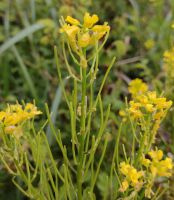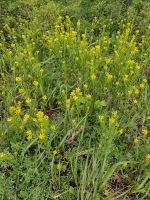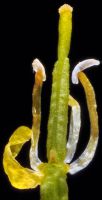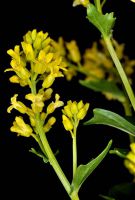Distribution: Occurring chiefly west of the Cascades crest in Washington; Alaska to California, east across most of North America to the Atlantic Coast.
Habitat: Garden escape, found chiefly in wet places.
Flowers: April-July
Origin: Introduced from Eurasia
Growth Duration: Biennial
Conservation Status: Not of concern
Pollination: Bees, butterflies
Mostly glabrous biennial from a taproot and simple crown, the stems stiff, erect, angled, single but freely-branched, 2-6 dm. tall.
Basal leaves long-petiolate, up to 12 cm. long, the blade usually lyrate-pinnatifid to pinnate, the lateral lobes 1-3(-5) on each side, entire to round-toothed, the terminal lobe ovate, entire or irregularly toothed, the petiole often with long, marginal hairs; cauline leaves alternate, glabrous, lobed, becoming simple and sagittate.
Inflorescence of compound or single and terminal racemes, with reduced racemes in the lower leaf axils; pedicles slender, 2-3 mm. long; sepals 4, pale yellowish-green, 2 mm. long; petals 4, yellow, spatulate-oblanceolate, 6-8 mm. long; stamens 6; style distinctly beak-like, 2-3 mm. long; stigma slightly lobed.
Siliques 1-3 cm. long and 1.5-2.5 mm. broad, slightly compressed, 4-angled, strongly 1-nerved full length, erect or strongly ascending, nearly straight.
Publication: Hortus Kew. 4: 109. 1812.
Barbarea vulgaris W.T. Aiton var. arcuata (Opiz ex C. Presl) Fr.
Barbarea vulgaris W.T. Aiton var. brachycarpa Rouy & Foucaud [Peck]
Erysimum arcuatum Opiz ex C. Presl
Erysimum barbarea L.
PNW Herbaria: Specimen records of Barbarea vulgaris in the Consortium of Pacific Northwest Herbaria database
WA Flora Checklist: Barbarea vulgaris checklist entry
OregonFlora: Barbarea vulgaris information
E-Flora BC: Barbarea vulgaris atlas page
CalPhotos: Barbarea vulgaris photos




















